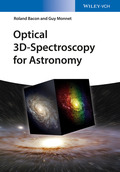Optical 3D-Spectroscopy for Astronomy

1. Edition April 2017
XIV, 276 Pages, Hardcover
122 Pictures (97 Colored Figures)
Practical Approach Book
Short Description
This must-have single source provides an up-to-date view of 3D Spectrographs widely used for astronomical observations. It treats visible, near-IR and near-UV, giving advice on the best observing strategy, instruments and how to manage the resulting data.
Over the last 50 years, a variety of techniques have been developed to add a third dimension to regular imaging, with an extended spectrum associated to every imaging pixel. Dubbed 3D spectroscopy from its data format, it is now widely used in the astrophysical domain, but also inter alia for atmospheric sciences and remote sensing purposes.
This is the first book to comprehensively tackle these new capabilities. It starts with the fundamentals of spectroscopic instruments, in particular their potentials and limits. It then reviews the various known 3D techniques, with particular emphasis on pinpointing their different `ecological? niches. Putative users are finally led through the whole observing process, from observation planning to the extensive ? and crucial - phase of data reduction.
This book overall goal is to give the non-specialist enough hands-on knowledge to learn fast how to properly use and produce meaningful data when using such a 3D capability.
Part 1: 3D Instrumentation
2 The Spectroscopic Toolbox
2.1 Basic Spectroscopic Principles
2.2 Optics & Coatings
2.3 Detectors
2.4 Interferometers
2.5 Dispersers
2.6 Mechanics & Cryogenics, Electronics
2.7 Management, Timeline & Cost
2.8 Exercises
3 Scanning Spectrographs
3.1 Scanning Long--Slit Spectrograph
3.2 Scanning Fabry--Perot Spectrograph
3.3 Scanning Fourier Transform Spectrograph
3.4 Exercises
4 Integral Field Spectrographs
4.1 Lenslet--based Integral Field Spectrograph
4.2 Fiber--based Integral Field Spectrograph
4.3 Slicer--based Integral Field Spectrograph
4.4 Exercises
5 New Trends in Integral Field Spectroscopy
5.1 Deployable Multi--object Integral Field Spectrograph
5.2 Paving the Field: parallel replicated Instruments
5.3 An Example: Autopsy of the MUSE wide--field Spectrograph
5.4 Exercises
6 Future Trends in 3D Spectroscopy
6.1 Photonics--based Spectrographs
6.2 Quest for the Grail: towards 3D Detectors
6.3 Exercises
Part 2: Using 3D Spectroscopy
7 Data Properties
7.1 Data Sampling
7.2 Noise Properties
8 Impact of Atmospheric Turbulence
8.1 Basic Principles
8.2 Seeing--limited Observations
8.3 Adaptive Optics Observations
8.4 Space--based Observations
9 Data Gathering
9.1 Planning Observations
9.2 Estimating Observing Time
9.3 Observing Strategy
10 Data Reduction
10.1 Basics
10.2 Specific Cases
11 Data Analysis
11.1 Kinematics
11.2 Spectrophotometry
11.3 Crowded Fields
11.4 Faint Point--like Sources
11.5 Faint Surface brightness Sources
11.6 Spatial Deconvolution
11.7 High Contrast Imaging
12 Conclusions
Bibliography
Annex 1: Hints to Exercises
Guy Monnet is an astrophysicist, with 50-year experience of developing astronomical instrumentation, on the ground and in space, mostly with a 3D spectroscopic flavor. Successively, he was director of the Marseilles Observatory, Lyon Observatory and the Canada France Hawaii Telescope Corporation. He then took the position of Head of Instrumentation at the European Southern Observatory (1995-2009) and the Australian Astrophysical Observatory (2010-2011). His main scientific domain is the dynamics of stars and ionized gas in galaxies.


